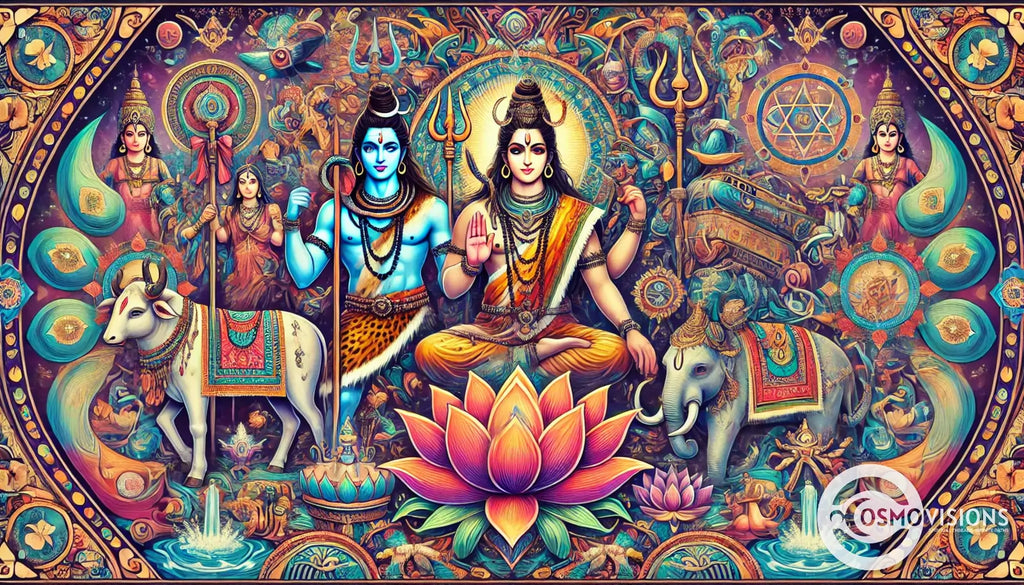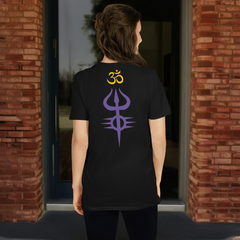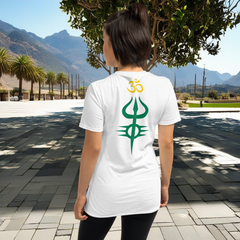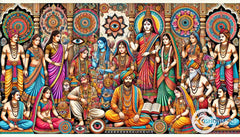The Sacred Bull Nandi: Symbol Of Devotion To Lord Shiva In Hinduism
Posted by Massimiliano Geraci

Who is Nandi in Hindu Mythology?
Nandi, the bull of Shiva, is a very special bull in Hindu stories. He is Lord Shiva’s vehicle and close friend, known as a Brahman bull with a hump on his back, horns, and a dewlap. Born from the sage Shilada, Nandi came into this world strong, with a body as tough as diamond.
This shows Nandi’s divine nature right from his birth. Since the time of the Kushan rulers around the 1st century CE, people have known Nandi as Shiva’s trusted companion.
This sacred bull stands guard outside many Hindu places of worship dedicated to Lord Shiva. His presence there is not just for protection but also a sign of purity and strength. Hindus show their respect to Nandi by offering prayers before praying to Lord Shiva because they hold him in high regard as both guardian and guide on their spiritual journey.
Nandi's Significance as Shiva's Sacred Bull
Since the Kushan dynasty, around the 1st century CE, Nandi has served as the sacred bull of the Hindu god Shiva. This role highlights a deep bond between deity and devotee within Hindu tradition.
As the chief guru of the eight disciples in the Nandinatha Sampradaya, his position extends beyond mere companionship to embody guidance and spiritual instruction.
Shiva temples across India place a statue of Nandi at their sanctum entrance, symbolizing purity, justice, and devotion. This positioning suggests that Nandi not only guards Shiva but also welcomes followers into a sacred space for worship.
Through this act, devotees engage with an ancient ritual that ties them directly to divine teachings and blessings.
The Symbolism Behind Nandi's Presence in Hindu Temples
In Hindu temples, the presence of Nandi, Shiva's sacred bull, holds deep meanings. This white-colored creature, whose bull symbolizes purity, represents purity and justice, key virtues in Hindu philosophy. Its location, always facing the entrance or the shrine dedicated to Shiva, teaches followers about devotion and guidance.
Nandi invites devotees into a space where they can leave behind the outside world and focus on spiritual growth. Respect for Nandi comes from understanding his role as both servant and guardian. This position near temple doors makes him a silent watcher over sacred spaces. It reminds people entering to purify their hearts and minds before approaching God Shiva. The white color of this humped bull further enriches its symbolic duty by representing cleanliness in thoughts and actions among worshippers.
Thus, Nandi serves not only as a vehicle for Lord Shiva but also as an emblem instructing individuals on living virtuous lives.
The Devotion and Worship of Nandi by Hindus
Hindus show deep respect to Nandi, seeing him as a significant figure among Hindu deities and the gatekeeper of Shiva’s world. They pray to Nandi with heartfelt devotion, believing he is not just a statue but a divine being who carries their messages straight to Lord Shiva.
This practice stems from stories where Nandi serves as an ardent devotee and loyal follower of Shiva. Temples dedicated to Shiva always feature Nandi sitting calmly, facing his master.
This setup symbolizes an eternal conversation between the deity and his faithful bull.
During festivals, worshipers dress images of Nandi in vivid colors and bring offerings like fresh grass, flowers, and fruits to honor him. Such acts highlight Hindus’ recognition of Nandi’s importance in reaching out to Lord Shiva.
In places like Varanasi, some bulls wander with marks showing they belong to Shiva—reflecting the belief in Nandi’s leadership among animals and his sacred role.

What Role Does Nandi Play in Hindu Rituals and Ceremonies?
Nandi holds a special place in Hindu rituals and ceremonies as Lord Shiva’s vehicle. Shiva and Nandi's association is deeply rooted in Hindu mythology, with Nandi serving as Shiva's chief attendant, means of transportation, and most ardent worshiper. People show him respect and include him in worship. They offer prayers to Nandi before praying to Shiva.
This practice underlines the bull’s role in connecting devotees with the deity. During important religious events, Hindus place flowers and make offerings to statues of Nandi found outside temples dedicated to Shiva.
These acts honor his devotion and service.
Nandi also appears in stories told during festivals celebrating Shiva’s power and compassion. His image, carved into temple gates, reminds people of his eternal watchfulness over sacred spaces.
Devotees walk around these images, believing that by doing so, they receive blessings for patience and strength from Nandi himself. This tradition reflects his enduring presence in the daily lives of those who follow Shiva.
Nandi as the Vehicle of Lord Shiva
Nandi serves as Shiva's animal form and the sacred vehicle for Lord Shiva, a role steeped in devotion and honor since ancient times. Found sitting in front of Shaivite temples, he faces the main sanctuary directly.
This position highlights his importance in connecting followers with the deity. His presence embodies purity and strength, offering a pathway to Shiva’s divine energy.
Crafted with skilled hands, Nandi’s images inspire awe among devotees and art lovers alike. Each sculpture from Tamil Nadu to Sri Lanka tells a story of faithfulness and service. As Lord Shiva’s faithful companion, Nandi witnesses countless prayers and ceremonies.
His form is more than just art; it bridges the earthly and the divine, guiding souls toward enlightenment.

Nandi's Symbolism in Hindu Festivals and Offerings
In Hindu festivals, people respect Nandi by giving him garlands and sweet food. This act honors his role in Shiva’s stories. Nandi conveys messages to Shiva, who destroys the world when it becomes evil to make way for beneficial change. During these times, devotees also pour milk over Nandi statues at temples.
This ritual cleans the soul and brings them closer to Shiva. Devotion comes in many forms; offering to Nandi is a step towards enlightenment. Artists paint Nandi’s image on temple walls and create sculptures that remind everyone of his strength and gentleness. These representations help followers feel connected during important celebrations like Shivaratri, where Nandi stands as a symbol of purity and devotion.
Nandi's Representation in Tamil Nadu's Temple Traditions
In Tamil Nadu, Nandi's presence takes a special place at Shaivite temple gates. The association of Nandi with Shiva can be traced back to very early Indian culture, a time when dairy farming was the most important occupation, explaining the sacredness of the cow and bull. Artists carve Nandi with great skill, often making him look like Lord Shiva himself. These statues show Nandi sitting calmly, watching over the temples.
His eyes seem to follow devotees, encouraging them in their spiritual journey.
Temple traditions in Tamil Nadu treat Nandi not just as Shiva’s vahana but as a wise teacher and protector. Every detail on these sculptures—like the third eye or crescent moon—tells stories from ancient scriptures.
This makes each visit to the temple a chance to learn more about Hindu beliefs and the deep bond between Shiva and his faithful companion.
How is Nandi Depicted in Hindu Art and Iconography?
Nandi, often referred to as the Indian ox, takes a special place in Hindu art, often shown as a proud and strong bull. Artists paint him sitting calmly, usually facing the entrance to Lord Shiva’s inner sanctum. This position shows his role as Shiva’s gatekeeper and loyal companion.
Nandi’s muscular body signifies his strength and determination. His calm face reflects focused concentration and devotion. In many images, intricate details on Nandi’s body—like jewelry and patterns—represent respect and honor for this sacred animal.
In various sculptures across temples in South India, Nandi appears in different sizes but always maintains a majestic presence. These sculptures capture more than just his physical form; they embody the deep bond between Nandi and Shiva.
Some artworks go beyond realism to give Nandi human-like features—an approach known as zoo-anthropomorphism—which connects divine attributes to earthly forms. Each depiction of Nandi invites worshippers to experience the virtues of loyalty, service, and pure dedication that he symbolizes within Hindu tradition.
The Anthropomorphic Characteristics of Nandi
In art and sculpture, Nandi takes on human traits in a form known as Nandikeshvara. The Sanskrit word 'nandi' means joy or happiness and is associated with the divine guardian of Shiva, playing a significant role in Shaivite texts and worship. This unique blend of bull and man embodies devotion and service to Shiva. Artists craft him with a strong man's body and a serene bull's head.
His eyes gaze forward, ever watchful over temples dedicated to Lord Shiva. Hands that once might have swung through fields now hold symbols of purity and strength—a trident represents Shiva’s power, while a small drum beats the rhythm of cosmic harmony. Nandikeshvara symbolizes unwavering faithfulness - standing guard, day after day. This depiction goes beyond mere artwork; it serves as a spiritual icon for followers. Hindus visiting these sacred spaces see Nandi not just as stone or metal but as the embodiment of their own steadfast faith towards Lord Shiva.

The Various Forms and Representations of Nandi in Hindu Scriptures
Nandi takes many shapes in Hindu stories, from a powerful white bull sitting outside temples to a bull-headed dwarf. Often depicted as a Brahman bull with a hump on the back, horns, and a dewlap, Nandi embodies divine characteristics and virtues like strength and patience.
This shows how important Nandi is on the spiritual journey. People see him as a guide who leads them closer to spirituality.
In art, Nandi also appears fully human, known as Nandikeshvara or Adhikaranandin. This mix of animal and human traits makes Nandi unique in religious symbols. It highlights his close connection to Shiva and his role as a protector of faith.
Through these various depictions, devotees understand more about devotion and duty in their lives.
What is the Cultural Significance of Nandi in Hindu Beliefs?
In Hindu traditions, the sacred bull symbolizes devotion to Lord Shiva. The name "Nandi" originates in Tamil, meaning growth or appearance. This revered creature's worship dates back to ancient times, notably seen in the Indus Valley civilization artifacts.
As a vehicle for Shiva, Nandi holds a place of honor in front of temple sanctuaries dedicated to the deity. This placement signifies Nandi's role as a protector and gatekeeper, ensuring only purity enters the god's abode.
The cultural significance of this celestial animal extends beyond mere symbolism; it embodies traits followers value: strength, fidelity, and righteousness. In temple art across India—especially Tamil Nadu—Nandi is depicted steadfastly watching over Shiva’s domains, often rendered sitting with a calm yet vigilant gaze directed towards the shrine within.
Through depictions in sculpture and scripture alike, devotees are reminded of their duties to uphold dharma (cosmic law and order) and seek spiritual enlightenment under Shiva’s guidance.
Worship practices involving Nandi include offering prayers before him as an intermediary to reach Lord Shiva himself, highlighting his importance not just in myth but also in everyday devotion.
Nandi's Association with Purity, Fertility, and Justice
Nandi's white color stands for purity and justice. This sacred bull guides people to live with honesty and fairness. In villages, Nandi is seen as a powerful sign of fertility. He promises good crops and healthy land to those who show him respect.
Farmers look up to Nandi, hoping their work will pay off with bountiful harvests.
This bull also represents justice in how we treat the earth and each other. Honoring Nandi reminds people to care for nature and share its gifts fairly. His presence in temples teaches us about balance — between taking from the land and giving back, between our needs and what is right.
Nandi's Role as a Guardian and Protector in Shiva Temples
Nandi sits at the entrance of Lord Shiva's place, always looking towards him. This shows Nandi as a strong guardian, watching over the spiritual gateway. His job is to keep watch and protect.
To see Nandi before seeing Shiva means you're entering a sacred space.
He represents a bridge between our world and the divine one. People respect him like a door-keeper who holds keys to deeper knowledge and purity. Through his silent gaze, Nandi invites believers into a realm where they can seek truth under Shiva’s guidance.
His presence is like a seal of approval for those coming to offer prayers, reminding them of the virtues of devotion and the protection of sacred spaces.
Nandi's Influence on the Shaivite Sect and Hindu Devotees
Nandi holds a special place in the hearts of those who follow Lord Shiva. As Shiva's trusted vehicle and a guide, Nandi teaches important lessons about devotion and living right. His figure at temple entrances is not just for show.
It reminds devotees to leave their egos outside before meeting Shiva. This practice shapes how people see the world and treat others, guiding them towards truth and kindness.
This sacred bull also leads Shiva’s followers on their spiritual journeys, showing them how to connect with divine powers. In stories and teachings, Nandi represents strength, loyalty, and faithfulness—all qualities that believers strive to embody in their lives.
Through rituals and prayers dedicated to him, people find deeper meanings in their faith, drawing closer to Shiva with Nandi's guidance.






















